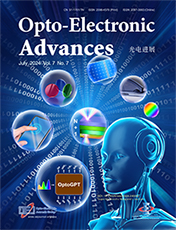2024 Vol. 7, No. 7
Cover story: Ma TG, Wang HZ, Guo LJ. OptoGPT: A foundation model for inverse design in optical multilayer thin film structures. Opto-Electron Adv 7, 240062 (2024).
Optical multilayer thin film structure is one of the most important photonic structures widely used in many applications, including color filters, absorbers, optical cavities or resonators, photovoltaic and radiative cooling, special mirrors for extreme UV lithography and for space telescopes. However, the “inverse” design of multilayer structures to satisfy the desired optical response is not an easy task, considering the difficulty of co-designing material and thickness as well as the diverse types of optical responses. In this paper, Prof. L. Jay Guo’s research group from the University of Michigan reports a new neural network model called OptoGPT to tackle the challenge of inverse design, with inspirations from the widely used GPT models. In this model, they introduced “structure tokens” to denote the material and thickness information and serialize a multilayer structure into a token sequence. In this way, for arbitrary optical response, the OptoGPT model can output any type of multilayer structure, with different number of layers, different materials, and thicknesses. They further propose to design for both transmission and reflection spectrum and use multiple techniques to extend to diverse responses. Using this model, they have successfully demonstrated a unified inverse design in different applications, including transmission filter, high reflection filter, perfect absorber, arbitrary absorber, and reflective/transmissive structural color, to name a few. Their model also works when designing different incident angles and polarization states, as well as simultaneous designs that can satisfy multiple angles and polarization requirements. Each design process is extremely fast and can be done within 0.1 seconds. This research significantly simplifies the inverse design process and sheds new light on unified design for photonic structures, making them easily accessible to researchers and engineers.

-
{{article.year}}, {{article.volume}}({{article.issue}}): {{article.fpage | processPage:article.lpage:6}}. doi: {{article.doi}}{{article.articleStateNameEn}}, Published online {{article.preferredDate | date:'dd MMMM yyyy'}}, doi: {{article.doi}}{{article.articleStateNameEn}}, Accepted Date {{article.acceptedDate | date:'dd MMMM yyyy'}}CSTR: {{article.cstr}}
-
{{article.year}}, {{article.volume}}({{article.issue}}): {{article.fpage | processPage:article.lpage:6}}. doi: {{article.doi}}{{article.articleStateNameEn}}, Published online {{article.preferredDate | date:'dd MMMM yyyy'}}, doi: {{article.doi}}{{article.articleStateNameEn}}, Accepted Date {{article.acceptedDate | date:'dd MMMM yyyy'}}CSTR: {{article.cstr}}

 E-mail Alert
E-mail Alert RSS
RSS


